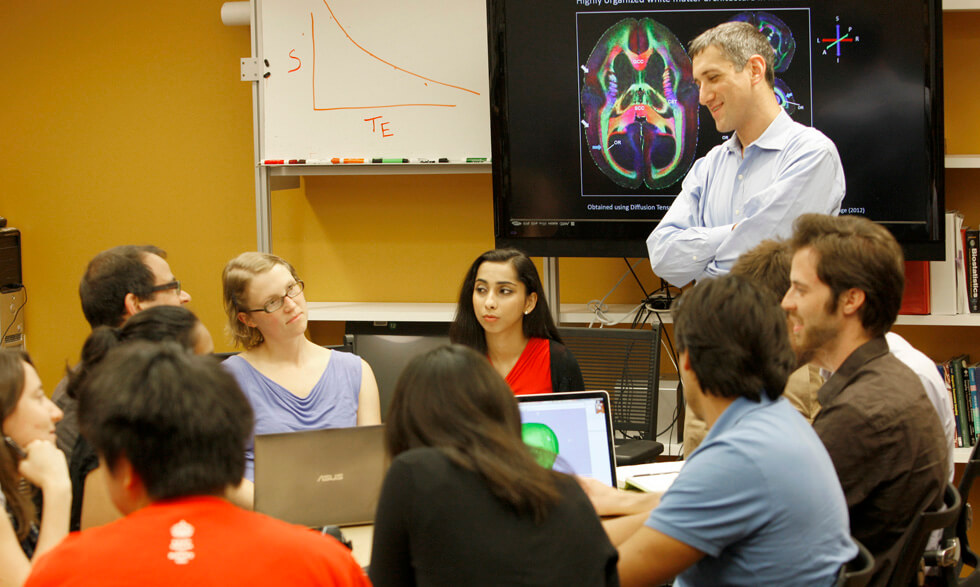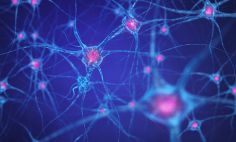An estimated 2.3 million people worldwide live with Multiple Sclerosis (MS).
MS is a hard-to-predict disease of the central nervous system. MS gets in the way of communication between our brains and our bodies. This creates symptoms like muscle weakness, numbness, coordination problems, and memory and thinking issues.
While there is no cure or known cause for MS, researchers have learned a lot about the disease thanks to magnetic resonance imaging (MRI).
MRI has changed how MS is diagnosed. It has reduced the time from early symptoms to diagnosis from years to months.
NIH MedlinePlus magazine spoke with Daniel Reich, M.D., Ph.D., a senior investigator, neurologist, and radiologist at the National Institute of Neurological Disorders and Stroke (NINDS). Dr. Reich leads clinical studies focusing on MS at NINDS.
How are MRIs used in MS research?
With a kidney or liver, you can take a biopsy or get bone marrow for research. With MS, we need access to the fluid that the brain makes. MRIs are beginning to help us see images to get the biology we need—and gives us different information from what we get from a spinal tap needle.
With my collaborators—physicists, engineers, doctors, junior scientists, and medical school students—we're trying to understand how MS starts. We also want to know how the damage caused by MS occurs in the brain so we can develop improved therapies. Modern, advanced medical imaging like MRI is helping us learn more about MS.
There are 15 approved medications available to reduce the amount of MS inflammation and stop MS attacks. They all work differently and have different side effects. The problem is that we don't have good approaches to repair or control cell damage caused by MS. We need to understand the biology. MRI was key in finding the 15 medications that we now have—and also for improved therapies in the future.
What are you most excited about with this research?
I'm excited that we are rapidly discovering biological ways for how we might repair and protect the brain. Within the last four years, we have a whole set of different families of drugs that appear to accelerate repair to the myelin (coating of nerve fibers) in animals. These are the first positive clinical trials. We're taking baby steps.
Twenty-five years ago, we began to break open the barriers to stop inflammation. Now we are prying open the door to repair therapy. I'm hopeful that in the next few years we'll have improved treatment for people.
What challenges do you face?
MS is a very complex disease that builds up over time. It's different for each person: how the nervous system reacts, how resilient your nerve cells are, where the inflammation exists, and much more. It's a lot of biological processes that play out over time. That makes it harder to analyze the cells over time.
The second challenge is that we don't know when or how the disease begins. We think that it may often begin in the teenage years, but MS is often silent when it starts—and people may not have their clinical first attack until their 20s or 30s. We know that genetics play a role, too.
What changes do you hope to see as a result of your research?
My number one goal is to stop the worsening of MS. I also hope that our research can help repair and prevent the cell damage and find out what causes the disease in some people. In other words, we want to shift our focus from stopping inflammation to stopping the disease. It's an ongoing evolution, but we can get there with outstanding imaging and more research.
What is your advice to those with MS?
Education is critical, because the landscape of MS is rapidly changing, and no one knows your disease better than you do.
Get involved with the MS community. The National Multiple Sclerosis society has excellent clinicians who can care for you and offer family support and education on MS.
Get involved with research, too. MS research starts with MS patients, and not every study involves experimental treatment. Ask your doctor about research studies you can participate in, and look into what's going on at nearby medical schools and at the NIH Clinical Center—America's research hospital.







